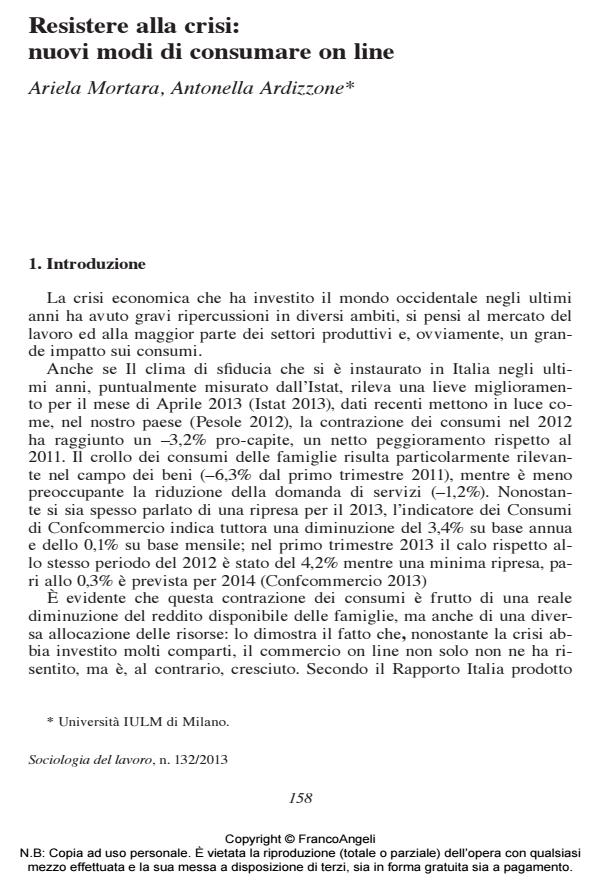Coping with the crisis: new ways of consuming on line
Journal title SOCIOLOGIA DEL LAVORO
Author/s Ariela Mortara, Antonella Ardizzone
Publishing Year 2013 Issue 2013/132
Language Italian Pages 13 P. 158-170 File size 259 KB
DOI 10.3280/SL2013-132012
DOI is like a bar code for intellectual property: to have more infomation
click here
Below, you can see the article first page
If you want to buy this article in PDF format, you can do it, following the instructions to buy download credits

FrancoAngeli is member of Publishers International Linking Association, Inc (PILA), a not-for-profit association which run the CrossRef service enabling links to and from online scholarly content.
E-commerce emerges as the economic sector that has best withstood the downshifting in consumption involving Italy. The growth of e-commerce is fostered by the spreading of the on line outlets, that offer, at a heavily discounted price, mostly clothing and accessories; by the skyrocketing diffusion of on line couponing sites, allowing people to have access, at a bargain price, to local services; and, last but not least, by the rapid spread of smartphones. The aim of the paper is to understand if the phenomenon of on line couponing is the effect of a new way of being consumers, i.e to be individuals who use their skills to enact strategies that allow them to limit their downsizing, to live new experiences and to recover a rational approach to consumption, thus affirming through consumption acts their social belonging. The paper discusses results emerging from an exploratory analysis, conducted through on line focus groups, on a sample of 21 consumers (15 women and 6 men), aged between 25 and 45 years, all buyers of on line coupons.
Keywords: E-commerce, on line coupon, focus group, economic crisis, consumption, internet
- Bawa K., Shoemaker R.W. (1989), “Analyzing incremental sales from a direct mail coupon promotion”, The Journal of Marketing, 53(3): 66-78. DOI: 10.2307/1251343
- Bloor M., Frankland J., Thomas M., and Robson K. (2001), Focus Groups in Social Research, London: Sage. DOI: 10.1108/14684521011099414
- Bonatti C. (2004), “I focus group on line”, in Di Fraia G. (a cura di), E-research. Internet per la ricerca sociale e di mercato, Milano: Laterza, pp. 171-186.
- Bourdieu P. (1983), La distinzione: critica sociale del gusto, Bologna: il Mulino.
- Casaleggio associati (2013), E-commerce in Italia 2013, testo disponibile al sito: /www.casaleggio.it/focus_download.php?titolo=E-commerce in Italia 2013&file (10 aprile 2013).
- ComScore (2013), comScore Reports $186.2 Billion in Full Year 2012 U.S. Retail E-Commerce Spending, Up 15 Percent vs. Year Ago, testo disponibile al sito: www.comscore.com/ita/Insights/Press_Releases/2013/2/comScore_Reports_186.2_Billion_in_Full_Year_2012_U.S._Retail_E-Commerce_Spending(15 aprile 2013).
- Confcommercio (2013), Consumi: a marzo il livello più basso dal 2000, testo disponibile al sito: www.confcommercio.it/-/a-marzo-il-livello-piubasso-dal-2000 (7 maggio 2013).
- Dholakia U.M., Kimes S.E. (2011), Daily deal fatigue or unabated enthusiasm? A study of consumer perceptions of daily deal promotions. September 11, testo disponibile al sito: http://ssrn.com/abstract=1925865, http://dx.doi.org/10.2139/ssrn.
- Eurispes (2012), 24° Rapporto Italia, testo disponibile al sito: www.eurispes.eu/content/social-shopping-il-nuovo-eldorado (10 aprile 2013).
- Eurispes (2013), 25° Rapporto Italia, testo disponibile al sito: www.eurispes.eu/content/rapporto-italia-2013-0 (10 aprile 2013).
- European Travel Commission (2013), New Media Trend Watch, testo disponibile al sito: www.newmediatrendwatch.com/regional-overview/103-europe?start=1(rilevato il 15 aprile 2013).
- Hsiao K.L., Lin J.C.C., Wang X.Y., Lung H.P. and H.J. Yu (2010), “Antecedents and consequences of trust in on line product recommendations: An empirical study in social shopping”, On line Information Review, 34(6): 935-953. DOI: 10.1108/14684521011099414
- Istat (2013), Fiducia dei consumatori, testo disponibile al sito: www.istat.it/it/archivio/fiducia (3 maggio 2013). Jeacle I., Carter C. (2011), “In TripAdvisor we trust: Rankings, calculative regimes and abstract systems”, in Accounting, Organizations and Society, 36(4), 293-309. DOI: 10.1016/j.aos.2011.04.002
- Lee M.K.O., Shi N., Cheung C.M.K., Lim K.H. and Sia C.L. (2011), “Consumer’s decision to shop on line: The moderating role of positive informational social influence”, Information and Management, 48(6): 185-191. DOI: 10.1016/j.im.2010.08.005
- Lichtenstein D.R, Netemeyer R.G. and Burton S. (1990), “Distinguishing Coupon Proneness from Value Consciousness: An Acquisition-Transaction Utility Theory Perspective”, The Journal of Marketing, 54(3): 54-67. DOI: 10.1177/0047287509346854
- Mangiaracina R., Perego A. (2009), “Payment systems in the B2c eCommerce: are they a barrier for the on line customer?”, Journal of Internet Banking and Commerce, 14(3), testo disponibile al sito: www.arraydev.com/commerce/jibc/2009-08/SI_Riccardo_2.pdf.
- Murray P. (1997), “Using Virtual Focus Groups in Qualitative Health Research”, in Qualitative Health Research, 7(4): 542-9. DOI: 10.1177/104973239700700408
- Netcomm (2012), E-commerce consumer behavior report 2012, testo disponibile al sito: www.ecommerceforum.it/ecommerceforum2012/interventi/sala-plenaria/(10 aprile 2013).
- Olbrich R., Holsing C. (2011), “Modeling consumer purchasing behavior in social shopping communities with clickstream data”, in International Journal of
- Electronic Commerce, 16(2): 15-40. DOI: 10.2753/JEC1086-4415160202
- Osservatorio eCommerce B2c (2012), I consumi 2012 in Italia: -2% offline,
- +18% on line… ma la partita è multicanale!, Milano: Politecnico di Milano.
- Pesole D. (2012), Recessione più lunga, slitta la ripresa. 14 settembre, testo disponibile al sito www.ilsole24ore.com/art/notizie/2012-09-14/recessione-lungaslitta-ripresa-063648.shtml?uuid=Ab9tTKdG (10 febbraio 2013).
- Pires G.D., Stanton J., and Rita P. (2006), “The internet, consumer empowerment and marketing strategies”, European Journal of Marketing, 40(9/10): 936-949. DOI: 10.1108/03090560610680943
- Racherla P., Friske W. (2012), “Perceived ‘usefulness’ of on line consumer reviews: An exploratory investigation across three services categories”, Electronic Commerce Research and Applications, 11: 548-559. DOI: 10.1016/j.elerap.2012.06.003
- Salvioli L. (2012), Chi assume? Facebook, Google, Amazon, Groupon, Linkedin…, 18 February, testo disponibile al sito: www.ilsole24ore.com/art/economia/2012-02-17/assume-internet-company-212407.shtml?uuid=AaWYfZtE (12 March 2012).
- Shankar A., Cherrier H., and Canniford R. (2006), “Consumer empowerment: a Foucauldian interpretation”, European Journal of Marketing, 40(9/10): 1013-1030. DOI: 10.1108/03090560610680989
- Shaw D., Newholm T. and Dickinson R. (2006), “Consumption as voting: an exploration of consumer empowerment”, in European Journal of Marketing, 40(9/10): 1049-1067. DOI: 10.1108/03090560610681005
- Stewart K., Williams M. (2005), “Researching on line populations: the use of on line focus groups for social research”, in Qualitative Research, 5: 395-416.
- DOI: 10.1177/146879410505691.VitaliM.(2012),Anno2015:50milionidismartphoneinItaliaearrivodellaNuovaInternet,testodisponibilealsito:http://lab.vodafone.it/news/2012/10/11/anno-2015-50-milioni-di-smartphone-in-italia-e-arrivo-della-nuova-internet/(10aprile2013
- Yoodeal (2011), Il mercato dei daily deals in Italia, testo disponibile al sito: www.tomshw.it/sito/img/zip/mkt.pdf (31 marzo 2012).
Ariela Mortara, Antonella Ardizzone, Resistere alla crisi: nuovi modi di consumare on line in "SOCIOLOGIA DEL LAVORO " 132/2013, pp 158-170, DOI: 10.3280/SL2013-132012